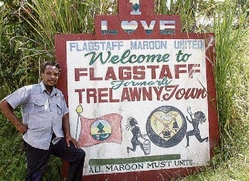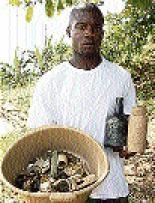
Michael Grizzle, chairman of the Local Forest Management Committee in Flagstaff, upper St James, stands proudly beside the community's welcome sign, as he gives a smile to The Gleaner's news team on a visit to the district. - Photos by Noel Thompson
As we observe National Heritage Week, today we begin a series by the Institute of Jamaica which highlights the heritage of communities across Jamaica. We want to hear from you. Send us your thoughts at editor@gleanerjm.com.
Flagstaff is a small-farming community in southern St James, which has grown up on the site of a famous Maroon village.
Located in the hilly Cockpit Country, it was originally called Trelawny Town - one of five Maroon villages officially recognised by the 1739 Treaty which ended the First Maroon War. However, it was the Second Maroon War of 1795-1796 that really highlighted the story of Flagstaff.
That war had its roots in tense relations between the Maroons and the British after the House of Assembly rejected a 1792 Maroon petition for additional lands to compensate for inadequacy and infertile Treaty allotments. In addition, the colonial government dismissed a popular white superintendent previously assigned to the community, replacing him with an unpopular official.
Prevention backfires
The lashing of two Maroons for pig stealing, carried out by a slave driver, added to the tension. Efforts to resolve the differences were ignored by the new and officious Lieutenant-Governor of Jamaica, the Earl of Balcarres, who was afraid of revolutionary fever spreading from nearby Haiti. On August 4, 1795, he declared martial law and deployed the militia to the outskirts of Trelawny Town. His subsequent imprisonment of several Trelawny Town Maroons and his threats of harsh treatment were major causes of the war that erupted on August 12.
The Maroons burned their own village and took to the bush. Skilled in guerrilla warfare, they enjoyed sporadic successes, but they were defeated after the British tracked them using bloodhounds and handlers imported from nearby Cuba.
Urged to surrender on the understanding that they would not be executed or transported, the population of Trelawny Town was nonetheless shipped out to Nova Scotia, Canada, in July 1796, and later sent on to the British settlement of Sierra Leone in West Africa.
Flagstaff might have got its name because of the military barracks and parade ground built in Old Town, where British soldiers were stationed until the mid-1800s.
The ruined foundations can still be seen, though much overgrown by bushes. Flagstaff now has a population of some 1,050 people.

Michael Grizzle stands beside a well, which was built by the British soldiers to support the barracks with water after the 1795 war between the British and the Maroons. It is still used as a source of water for domestic purposes, as there is not much surface water in the Flagstaff Cockpit Country. There is also no potable water in Flagstaff.

Javian 'Jay' Headley holds artefacts that were found in the community over a period of time.